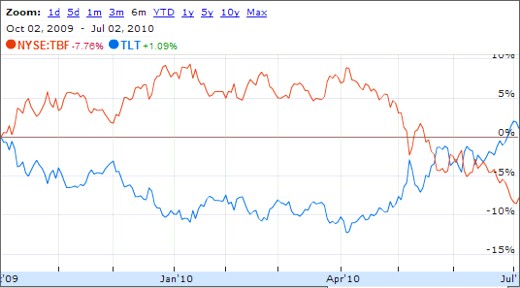You knew it was coming, and now it’s finally arrived: the first Canadian ETF that shorts the bond market. On June 29, the Claymore Inverse 10 Year Government Bond ETF (CIB) began trading on the TSX. The fund is designed to deliver the opposite of the daily return of 10-year Government of Canada bonds. In other words, it caters to the Fear of the Month: rising interest rates.
Of course, bond prices fall when interest rates rise, and long-term bonds are the most sensitive to this risk. For more than a year, since the overnight rate bottomed out at 0.25% last April, pundits have been warning investors away from long maturities, which seem certain to fall. Meanwhile, amid all the anxiety, the iShares DEX Long Term Bond Index Fund (XLB) has returned more than 14% in the last 14 months, including distributions. The lesson here is that attempts to forecast interest rate movements is rank speculation.
That’s why this new Claymore ETF scares me. I’m concerned that Couch Potato investors, worried their bond holdings are “certain” to fall in the near future will think this product can offer some safety. Indeed, Claymore’s website suggests that CIB can be used to “hedge portfolios against rising interest rates and effects of inflation.” Maybe it can in the very short-term, and perhaps it may be a useful arrow in the quiver of a professional money manager, since bonds are difficult to sell short. But an inverse ETF has no place in long-term investor’s portfolio.
Like all inverse ETFs, this one is designed to deliver returns based on daily price movements. Over a few weeks or even a couple of months, it should perform as expected — if bond prices go down 2% over this short period, CIB should go up about 2%. However, market volatility is a constant drag on your returns, and over a long period these small losses compound. That’s why inverse ETFs can be terrible investments, even if they’re held for less than year.
Inverse bond ETFs are already traded in the US, so you can see this for yourself. Here’s a Google Finance chart comparing the returns of the Barclays 20+ Year Treasury Bond Fund (TLT) and its inverse counterpart, the ProShares Short 20+ Year Treasury (TBF):

As you can see, over the last nine months, long-term Treasuries were up 1%. But if you held the TBF during that same period, you didn’t lose 1%, you lost almost 8%. That’s because the longer you hold an inverse ETF, the more the volatility chips away at you. The paths of these two ETFs appear to be mirror images at first glance, but if you look closely, you’ll notice that the red line is always closer to 0% than the blue line. In May of this year, bonds were still down, but by this time so was TBF. Investors who guessed right about bonds still lost money.
It’s also crucial to note that TLT pays a yield of about 4%, so investors still get a decent return when the market price goes nowhere. Inverse bond ETFs do not pay distributions: in a flat market they just keep eroding your returns.
Don’t take my word for it. If you don’t believe that this ETF is strictly for short-term gambling, consider these excerpts from the fund’s prospectus:
- “Investment in the Units of the Claymore Inverse 10 Yr Government Bond ETF is speculative and involves a high degree of risk.”
- “Investors should monitor their investment in the Claymore Inverse 10 Yr Government Bond ETF daily.”
- “Returns over periods longer than one day will likely differ in amount and possibly direction from the performance of the 10 Year [Government of Canada] Bond for the same period.”
- “An investor may lose a substantial portion or even all of the money invested in the Claymore Inverse 10 Yr Government Bond ETF.”
- “Market conditions may make it difficult or impossible for the Claymore Inverse 10 Yr Government Bond ETF to liquidate a position.”
I’ll add a warning label of my own: “Long-term investors should avoid exposure to inverse bond ETFs. If marketing material is swallowed, induce vomiting. If your portfolio comes into contact with interest rate movements or inflation, diversify your bond holdings immediately. Seek shelter and cover ears.”














